The Future Has Spoken: It’s Time to Shut Down DAPL and Stop Line 3
Frontline Indigenous youth, who have been standing up against destructive oil pipelines for years, are imploring President Biden to join them in protecting their water, lands, and cultures.
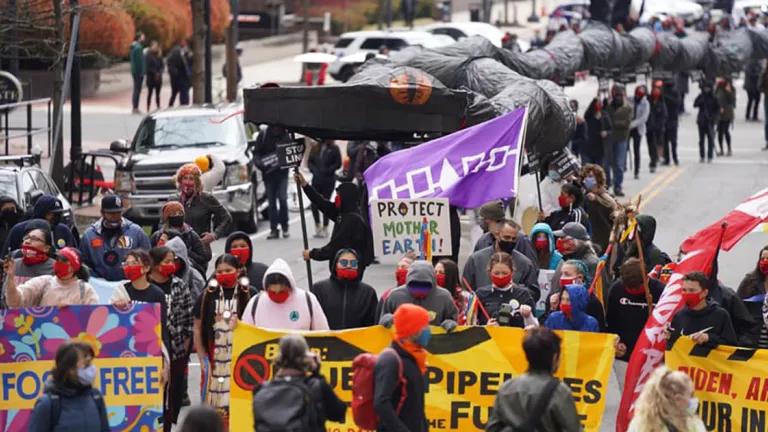
Indigenous youth on the streets of Washington, D.C., at the Frontlines day of action
Nedahness Greene/Indigenous Environmental Network
On April 1, Maya Monroe Runnels-Black Fox found herself back in downtown Washington, D.C., marching under the shadow of a giant black snake. It was her second trip from Standing Rock to the U.S. capitol in five years—the last time in July 2016—and one of dozens of pipeline protests she’s attended. For the 19-year-old president of the Standing Rock Youth Council, the call to shut down the Dakota Access Pipeline (DAPL) is a cause she’s been championing for more than a quarter of her lifetime.
Runnels-Black Fox was one of the organizers behind the Frontlines to D.C. day of action, which the Youth Council and other Indigenous groups planned to coincide with the fifth anniversary of the founding of Sacred Stone Camp that had stood in opposition to DAPL for nearly a year. In addition to rallies and dancing, the event included a 2.8-mile run around the National Mall and a march with the activists’ signature 200-foot snake puppet (a symbol of the pipeline itself) to the White House. The participants also stopped by the U.S. Army Corps of Engineers’ headquarters to deliver hundreds of thousands of petitions opposing both DAPL and Line 3, a tar sands pipeline under construction across northern Minnesota. After dark, they set up a light projector to display phrases like “Mní Wičóni” (Water Is Life), “Executive Order Now,” and “Respect Us or Expect Us” across the building.
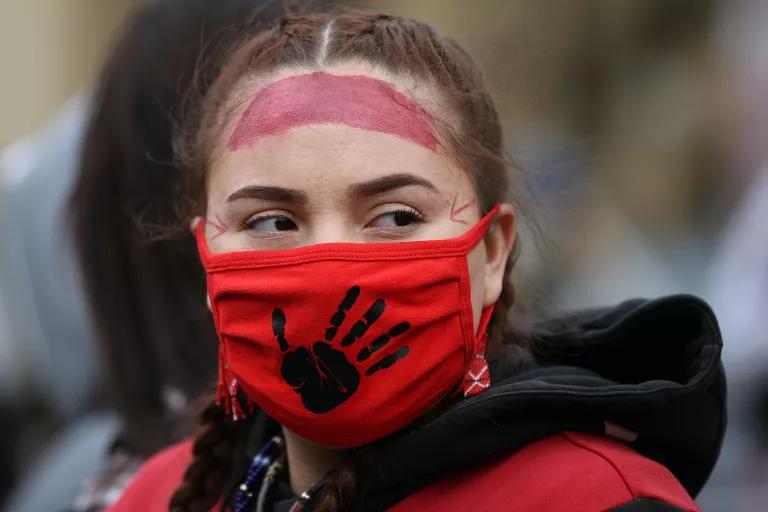
Maya Runnels-Black Fox, president of the Standing Rock Youth Council, at an April 1, 2021, protest against DAPL and Line 3
Chip Somodevilla/Getty Images
Their message for President Biden was clear: Be the climate leader you pledged to be and build back fossil-free.
“It was really empowering to have a lot of support from not only our own people, but from people across the world,” says Runnels-Black Fox. Thousands of frontline Indigenous youth and organizers fighting DAPL and Line 3—as well as the Keystone XL, Enbridge Line 5, and Mountain Valley pipelines—showed up for the day of action, and allies showed their support both in person and virtually. “It was a positive feeling, but it was also kind of sad because, after five years, there is still no action on the government's behalf.”
Ten-year-old Love Hopkins was there too, dressed in a traditional ribbon skirt paired with a “Straight Outta Standing Rock” T-shirt, and toting a file box plastered with a sign: “400,000+ messages to stop Line 3 and DAPL.” Like Runnels-Black Fox, Hopkins made both trips to Washington, D.C.—the first when she was just six. “It didn't feel good to be there,” she reflects after the trip, from her home in White Shield, North Dakota. “We shouldn't have to go a long way just to tell people that this is not OK, and it needs to stop.”
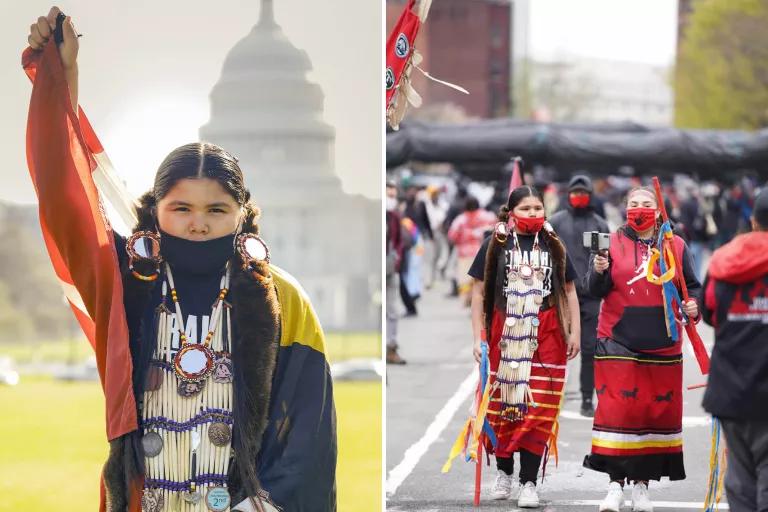
From left: Love Hopkins in front of the Capitol building in Washington, D.C.; Hopkins and Maya Runnels-Black Fox leading the protest toward the Capitol
Nedahness Greene/Indigenous Environmental Network (2)
The 1,172-mile Dakota Access Pipeline, which started transporting oil in May 2017, begins in the Bakken fields in northwestern North Dakota, snakes through South Dakota and Iowa, and ends at an oil terminal near Patoka, Illinois. Along the way, a half-million daily barrels of crude pass under the Missouri River and Lake Oahe, a reservoir that is the primary water source for the Standing Rock Reservation.
While the Biden administration immediately issued an executive order canceling the Keystone XL pipeline upon taking office, it has not taken a similar stance on DAPL or Line 3. In fact, a little over a week after the April 1 day of action, the president chose not to shut down DAPL, proceeding instead with a court-ordered environmental review.
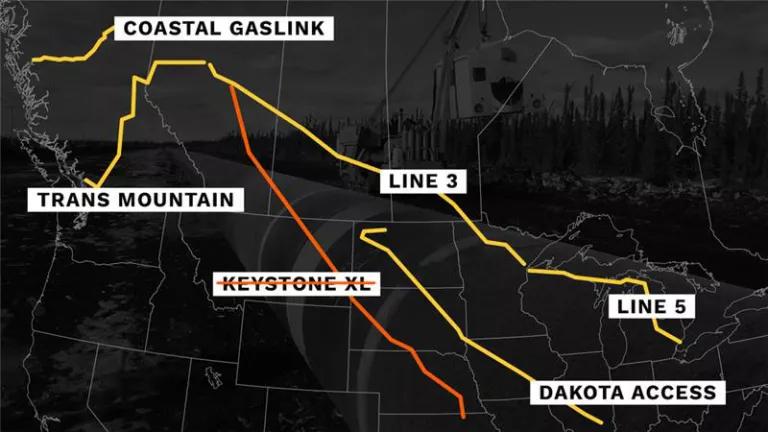
Extinction Rebellion
Still, the activists will not back down. Indeed, last month’s trip to Washington, D.C., was just the latest in a series of Indigenous youth–led public actions highlighting the threats these pipelines pose to their water, land, and communities—as well as the global climate. The Standing Rock Youth Council is perhaps most well-known for organizing long-distance relay runs that not only garnered attention, but, critically, helped unify young Indigenous people around resistance to DAPL.
The first DAPL relay took place in April 2016, when council members ran 500 miles from the Standing Rock Sioux reservation in North Dakota to the Army Corps of Engineers’ office in Omaha, Nebraska, where they delivered petitions urging a permit denial for DAPL. Another run took place in February of this year when the group, together with Cheyenne River Grassroots Collective, set out for a 93-mile relay in subzero temperatures from South Dakota back to Sacred Stone Camp. “Running is praying too—in a physical way,” said Bobbi Jean Huyamni, one of the original runners to D.C., in a video documenting the recent journey back from D.C. “Wherever we ran, where we laid our footprints down, our prayers down, it was heard not just through our nation but throughout Oceti Sakowin,” she said. “It woke up this common sense of feeling like you belong to something. You feel like you need to stand up, or you just need to do something.”
Since its early days in 2016, the DAPL resistance movement has worked in solidarity with frontline communities to stop the Line 3 tar sands pipeline expansion in Minnesota—what oil giant Enbridge calls a “replacement” for its nearly 60-year-old pipe in another part of the state, but what is in fact a brand-new, larger line across most of the state. If built, the project would send up to 790,000 barrels of tar sands crude per day into the United States. Line 3 would also run beneath the Fond du Lac Reservation and cross more than 200 bodies of water, including the Mississippi River—twice.
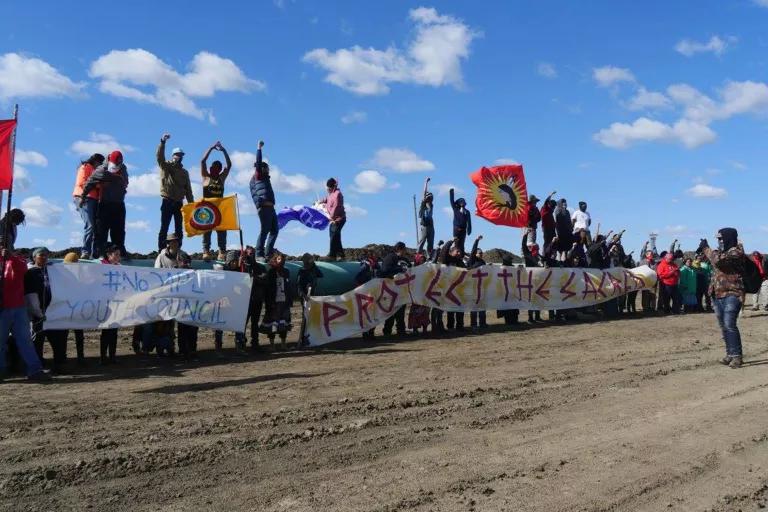
At Standing Rock in 2016, where many of the DAPL protests first began
Nedahness Greene/Indigenous Environmental Network
As with DAPL, Line 3’s construction violates Indigenous sovereignty and treaty rights and has failed to abide by the United Nations Declaration on the Rights of Indigenous People, which requires free and prior informed consent. The pipeline has also contributed to the Missing and Murdered Indigenous Women crisis, an epidemic of violence against Indigenous women that’s been exacerbated by the temporary work camps set up near pipeline projects. The camps, often on or near Native land, bring a sudden influx of workers to rural communities where they often escape close scrutiny by law enforcement. A 2019 Bureau of Justice Statistics report found, for example, a 70 percent jump in aggravated assault and a nearly 45 percent increase in unlawful sexual contact near North Dakota’s Bakken oil fields.
“There’s a lot of similarities when it comes to threatening Indigenous lands,” says Runnels-Black Fox. “They’re a huge threat because they’re right on our home. So we’re standing together and uniting over that. And as Indigenous youth, we’re taught to think seven generations down, so we’re not only thinking about ourselves—we are thinking about the future.” The teaching she refers to is based on an ancient Iroquois philosophy, which instructs all people to consider the impact of our decisions on the following seven generations.
One of the many concerns about Line 3 is how it will affect the Minnesota lakes where wild rice, called manoomin, grows. The local Ojibwe people have relied on this food for centuries, and it grows nowhere else in the world. The pipeline is slated to cross beneath 42 rice lakes.
Silas Neeland, a 13-year-old White Earth Nation member from Rice Lake, Minnesota, is speaking up on behalf of these threatened ecosystems. Neeland traveled to D.C. as part of the Frontlines contingent to share his story.
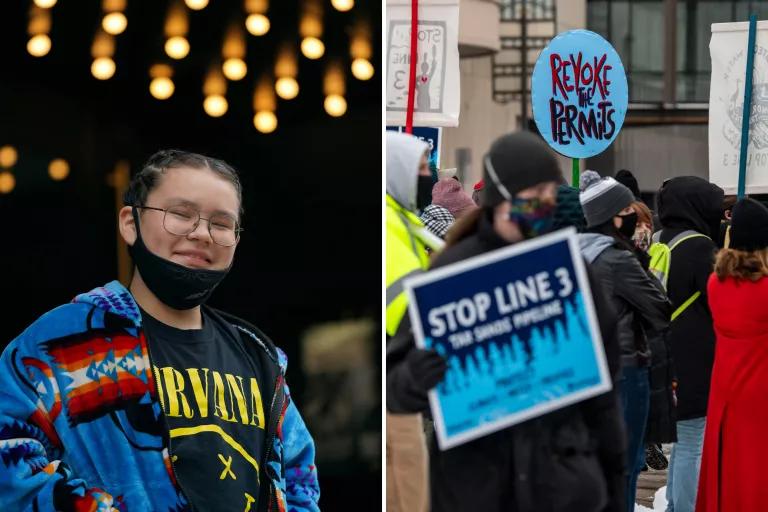
From left: Portrait of Silas Neeland in Washington D.C. April 1st; Indigenous groups and opponents of the Enbridge Energy Line 3 oil pipeline replacement project protest its construction across northern Minnesota. The proposed route for Line 3 crosses 227 lakes and rivers, including the Mississippi River and rivers that feed directly into Lake Superior.
Nedahness Greene/Indigenous Environmental Network; Michael Siluk/Education Images/Universal Images Group via Getty Images
“I went to Washington, D.C., to tell Biden he needs to respect our wild rice, our treaties, and our sacred water before this pipeline does any damage,” he says. “It taught me that there are so many people fighting fossil fuels, and that we’re going to keep fighting this black snake until it dies.” Neeland, who recently participated in a hunger strike to protest Line 3, worries that the rice, a crucial staple in his family’s pantry and a crop that can’t be grown from seed, would be wiped out forever by a pipeline spill. ”Manoomin is who we are as people,” he says.
Meanwhile, Neeland has a message for President Biden: “You claim to be a climate president, but Line 3 is disrespecting our treaties, our wild rice, and our water, and the great Mississippi River. So, all I ask is for you to stop Line 3.”
The youth activists are waiting for the president to take note of their demands—and honor his own pledge to not just slash carbon emissions in half but also build a liveable future for the next generation. “Why hasn't he done anything to end any of this?” asks Alyssa Marshall, a 17-year-old from Bullhead, South Dakota. “End DAPL, end Line 3, build back fossil-free, or help Indigenous people?” Marshall joined the Standing Rock Youth Council last December and says she lives in constant fear of a pipeline accidentally poisoning her drinking water.
“We were there, right in front of the White House, protesting peacefully. We just want a better community for us to grow.”
This NRDC.org story is available for online republication by news media outlets or nonprofits under these conditions: The writer(s) must be credited with a byline; you must note prominently that the story was originally published by NRDC.org and link to the original; the story cannot be edited (beyond simple things such as grammar); you can’t resell the story in any form or grant republishing rights to other outlets; you can’t republish our material wholesale or automatically—you need to select stories individually; you can’t republish the photos or graphics on our site without specific permission; you should drop us a note to let us know when you’ve used one of our stories.

This Is How We Stand Up to Trump
A Trailblazer for Tribal Sovereignty
Deb Haaland Is the Interior Secretary Our Country Needs
This Is How We Stand Up to Trump
A Trailblazer for Tribal Sovereignty
Deb Haaland Is the Interior Secretary Our Country Needs
This Is How We Stand Up to Trump
A Trailblazer for Tribal Sovereignty
Deb Haaland Is the Interior Secretary Our Country Needs
This Is How We Stand Up to Trump
A Trailblazer for Tribal Sovereignty